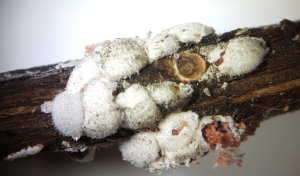
See all posts by this author

Photo courtesy of Helene Doughty, Virginia Polytechnic Institute and State University, Bugwood.org
Crape myrtle bark scale (CMBS) is an invasive pest that affects crape myrtles. Infestations result in a black sooty mold due to the honeydew excreted by these tiny insects, causing the trees to look unsightly. Often this gross covering will extend to your patio furniture, hardscapes, and other outdoor items. We find CMBS present on boxwoods in our area as well. Prevention is the best solution, usually best done in the winter.
Of course, prevention and treatment for crape myrtle bark scale is included in a Plant Health Care subscription from Arborscapes. (As are myriad other pests and diseases) If you would like to become a part of our Plant Health Care program, reach out to Arborscapes today! Your living landscape will be the envy of the entire neighborhood!
For our friends who enjoy the DIY process, here’s how you can manage and treat crape myrtle bark scale:
Physical and Cultural Controls
- Hand Removal: For minor infestations, scales can be removed by hand or by scrubbing the branches and trunks with a soft brush and soapy water.
- Pruning: Prune and dispose of heavily infested branches. This can help reduce the scale population and improve the effectiveness of other treatments.
Biological Control
- Lady Beetles: Certain lady beetle species, such as the twice-stabbed lady beetle, have shown to be effective predators of CMBS.
- Parasitic Wasps: Some tiny wasps lay their eggs in scale insects, and upon hatching, the larvae consume the scale from the inside.
Insecticidal Treatments
- Horticultural Oils: These can be applied during the dormant season or growing season. They work by smothering the scales. However, thorough coverage is essential for efficacy.
- Insecticidal Soaps: These can help in reducing the scale population, but they need to be applied thoroughly, covering all infested surfaces. Multiple applications might be necessary.
- Systemic Insecticides: Products containing imidacloprid (such as Bayer Advanced Tree & Shrub Insect Control) or dinotefuran (like Safari) can be applied as soil drenches or as trunk applications. These insecticides are taken up by the tree and are ingested by the scales when they feed on the tree’s sap. Apply systemic insecticides in late winter to early spring for best results.
Avoid Excessive Nitrogen Fertilization
- High nitrogen levels can promote tender new growth, which can be more susceptible to CMBS and other pests. It’s best to balance your fertilization practices.
Regular Monitoring
- Regularly inspect your crape myrtles for signs of CMBS. Early detection and treatment can prevent severe infestations and associated damage.
- Look for the white or grayish cottony appearance of the scale, mainly on the branches and trunks.
Maintain Plant Health
- A healthy plant can better withstand pest pressures. Ensure proper watering, avoid unnecessary wounding, and provide balanced nutrition.
When applying any insecticides, always follow the label instructions. Additionally, consider the potential impacts on beneficial insects and pollinators. The combination of cultural, biological, and chemical treatments will offer the most effective control against CMBS. More information on CMBS is available at the University of Maryland website.
And if all of this sounds like too much work, contact Arborscapes to subscribe to our Plant Health Care program, and we will take care of this, other pests, fertilization and health concerns for your living landscape!
See all posts by this author
